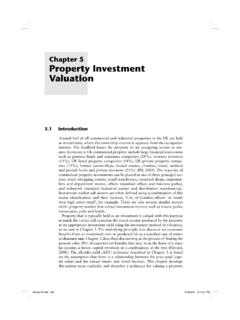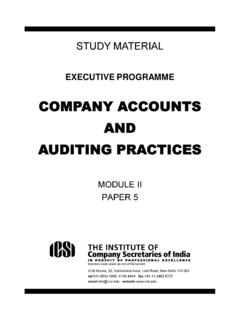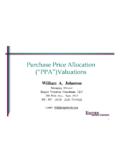Transcription of DISCOUNTED CASH FLOW ANALYSIS FOR …
1 valuation GUIDANCE NOTE NO. 9 THE COST APPROACH FOR FINANCIAL REPORTING-(DRC) DISCOUNTED CASH FLOW ANALYSIS FOR market VALUATIONS AND INVESTMENT ANALYSESREVISED DISCOUNTED cash fl ow (DCF) ANALYSIS is a fi nancial modelling technique based on explicit assumptions regarding the prospective income and expenses of a property or business. Such assumptions pertain to the quantity, quality, variability, timing, and duration of infl ows and outfl ows that are DISCOUNTED to present value. DCF ANALYSIS , with appropriate and supportable data and discount rates, is one of the accepted methodologies within the income capitalization approach to valuation .
2 DCF ANALYSIS has gained widespread application due in part to the advancement of computer technology. DCF ANALYSIS is applied in valuations of real property, businesses and intangible assets; in investment analyses; and as an accounting procedure to estimate value in use. The use of DCF ANALYSIS has increased substantially in institutional, investment property and business valuation sectors and is frequently required by clients, underwriters, fi nancial advisers and administrators, and portfolio managers. DCF valuations, as with other income-based valuations, are established on ANALYSIS of historical data and assumptions about future market conditions affecting supply, demand, income, expenses, and the potential for risk.
3 These assumptions determine the earning capability of a property or business upon which the pattern of its income and expenditures/outgoings is The objective of this Guidance Note (GN) is to prescribe Generally Accepted valuation Principles (GAVP), best practice, and due diligence measures for Valuers to follow in performing DCF ANALYSIS for market and non- market based valuations and to distinguish between applications of DCF ANALYSIS in these two different types of valuation This GN applies to market and non- market valuations developed by means of DCF ANALYSIS . It discusses the structure and components of DCF models and the reporting requirements for valuations based on DCF The scope of this GN extends to the reasonableness and supportability of the assumptions upon which the DCF analyses are based.
4 Assumptions made in any valuation directly affect the value conclusion. In accordance with the IVSC Code of Conduct, all assumptions underlying a valuation should be likely, reasonable, and Defi Discount Rate. A rate of return used to convert a monetary sum, payable or receivable in the future, into present value. Theoretically it should refl ect the opportunity cost of capital, , the rate of return the capital can earn if put to other uses having similar DISCOUNTED Cash Flow ANALYSIS (DCF). A fi nancial modelling technique based on explicit assumptions regarding the prospective cash fl ow to a property or business. As an accepted methodology within the income approach to valuation , DCF ANALYSIS involves the projection of a series of periodic cash fl ows either to an operating property, a development property, or a business.
5 To this projected cash fl ow series, an appropriate, market -derived discount rate is applied to establish an indication of the present value of the income stream associated with the property or business. In the case of operating real properties, periodic cash fl ow is typically estimated as gross income less vacancy and collection losses and less operating valuation AND PROPERTY valuation GUIDANCE NOTE NO. 9expenses/outgoings. The series of periodic net operating incomes, along with an estimate of the reversion/terminal value/exit value, anticipated at the end of the projection period, is then DISCOUNTED . In the case of development properties, estimates of capital outlays, development costs, and anticipated sales income are estimated to arrive at a series of net cash fl ows that are then DISCOUNTED over the projected development and marketing periods.
6 In the case of a business, estimates of periodic cash fl ows and the value of the business at the end of the projection period are DISCOUNTED . The most widely used applications of DCF ANALYSIS are the Present Value (PV), or Net Present Value (NPR) and the Internal Rate of Return (IRR) of cash fl ows. Financial Modelling. The projection of a business or property s periodic income or cash fl ow pattern from which measures of fi nancial return can be calculated. Income or cash fl ow projections are generated through the use of a fi nancial model that takes into account historical relationships between income, expense, and capital amounts as well as projections of those variables.
7 Financial modelling may also be used as a management tool to test expectations for property performance, to gauge the integrity and stability of the DCF model or as a method to replicate the steps taken by investors in making decisions involving the purchase, sale, or holding of a property or business. Internal Rate of Return (IRR). The discount rate that equates the present value of the net cash fl ows of a project with the present value of the capital investment. It is the rate at which the Net Present Value (NPV) equals zero. The IRR refl ects both the return on the invested capital and the return of the original investment, which are basic considerations of potential investors.
8 Therefore, deriving the IRR from ANALYSIS of market transactions of similar properties having comparable income patterns is a proper method for developing market discount rates for use in valuations to arrive at market Value. Investment ANALYSIS . A study undertaken for the purposes of development and investment, the evaluation of investment performance, or the ANALYSIS of a transaction involving investment properties. Investment analyses are variously called (economic) feasibility studies, market or marketability analyses, or fi nancial projection studies. Net Present Value (NPV). The measure of the difference between the DISCOUNTED revenues, or infl ows, and the costs, or outfl ows, in a DISCOUNTED cash fl ow ANALYSIS .
9 There is little real distinction between NPV and Present Value (PV). NPV is normally used to describe the difference between all DISCOUNTED infl ows and outfl ows while PV is often used where the initial outlay or price is not included in the cash fl ow. In a valuation that is done to arrive at market Value, where DISCOUNTED cash fl ows and the discount rate are market derived, the resulting NPV should be indicative of the market Value and is often termed PV rather than NPV. Relationship to Accounting Discounting is a standard procedure employed by accountants in considering the time value of The International Financial Reporting Standards (IFRSs) prescribe a discounting procedure to estimate the value in use of an asset.
10 An estimate of the value in use involves a) estimating the future cash infl ows and outfl ows to be derived from the continuing use of the asset and from its ultimate disposal and b) applying the appropriate discount rate to these future cash fl ows. (IAS 36, para. 31) IAS 36, states that the discount rate (rates) shall be a pre-tax rate (rates) that refl ect(s) current market assessments of: (a) the time value of money; and (b) the risks specifi c to the asset for which the future cash fl ow estimates have not been adjusted . It is also true that other measures of income or cash fl ow may be used so long as the discount rate(s) are appropriately matched with the income fl ow(s).







